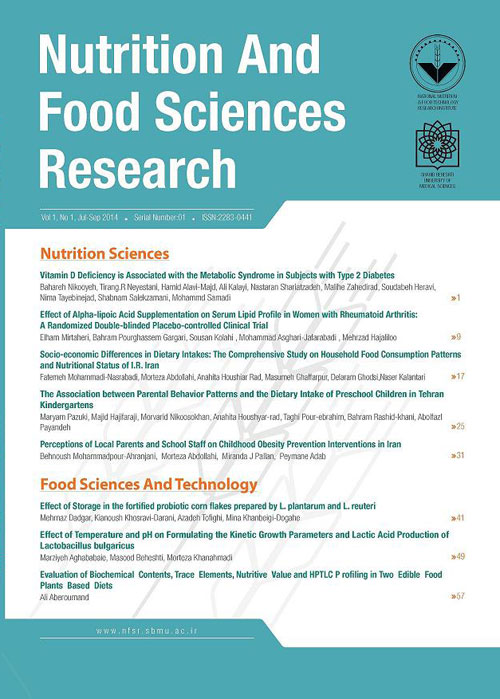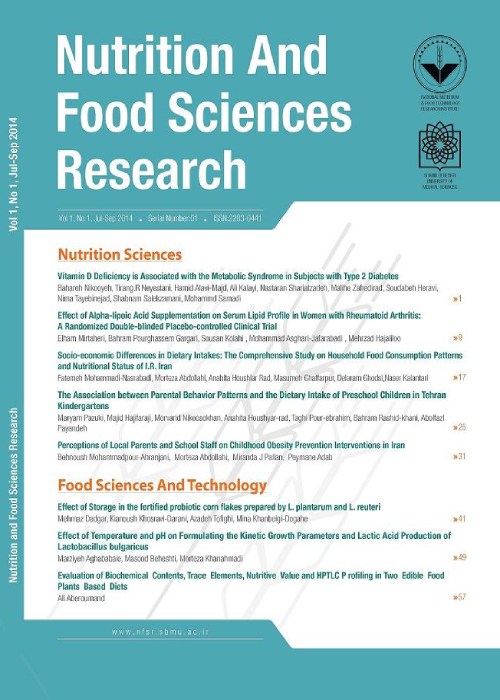فهرست مطالب

Nutrition & Food Technology Research
Volume:5 Issue: 1, Jan-Mar 2018
- تاریخ انتشار: 1396/11/24
- تعداد عناوین: 7
-
-
Pages 1-10Background And ObjectivesTo provide efficient recommendation for the prevention of childhood obesity and eating disorders, it is necessary to understand and explore their dietary patterns (DPs). The main aim of the current study was to explore dietary patterns among primary school aged children and determine the relationship between different dietary patterns and factors including anthropometric measurements, family size, school performance, weekly consumption of breakfast and physical activity.Materials And MethodsMale and female primary school children aged 7-11 (n= 761) were recruited in a cross-sectional study from all districts of Tehran(2003-2004). The students and their caregivers (mainly their mothers) were interviewed to complete a 24 h recall. Dietary patterns were explored by exploratory factor analysis of the 23 food groups.ResultsThree major DPs were identified: healthy, transitional and western. The tendency of children towards western diet increased with their age (PConclusionsEffective interventions for adapting older children and larger families to healthy eating is urged..For better judgment about correlation of DPs and adiposity more studies are recommended.Keywords: Dietary patterns, Pediatric, Adiposity, School
-
Pages 11-16Background And ObjectivesReports indicate that hypovitaminosis D is extremely common worldwide and is re-emerging as a major health problem globally. In the present study, the main objectives were: 1) to examine whether healthy men and women living in Ahvaz have adequate vitamin D status; 2) to assess association between vitamin D status and some cardiometabolic risk factors.Materials And MethodsThis was a cross-sectional study which was part of the National Food and Nutrition Surveillance (NFNS). A total of 235 apparently healthy women and men aged 20-60 met the inclusion criteria from the city of Ahvaz (latitude 31.3oN, 48.6oE). Anthropometric measurements including weight and height were taken. Serum 25-hydroxyvitamin D (25(OH)D) concentrations and lipid profile including triglycerides, total cholesterol, LDL-C and HDL-C were evaluated.ResultsMean circulating 25(OH)D concentration was 25.4±12.7 nmol/L, with significant difference between men and women (p=0.015). Only 6 % of the participants had sufficient levels of vitamin D (25(OH)D ≥ 50 nmol/L). Results of logistic regression analyses after controlling for gender showed that subjects with hypovitaminosis D were almost 4.38 times more likely to be overweight/obese compared with subjects with vitamin D sufficiency (OR:4.38, p:0.011). There was no significant association between serum 25(OH)D concentration and the lipid profile components.ConclusionsWe found high prevalence of hypovitaminosis D in apparently healthy adults in Ahvaz, a sunny city of Iran. Our findings suggest that high vitamin D concentrations among the adult population are associated with a substantial decrease in body mass index. However, there was no association with the lipid profile components.Keywords: Vitamin D, Ahvaz, Cardiometabolic risk factors
-
Pages 17-23Background And ObjectivesBeyond the influence of anthropometric, demographic and race, nutrition is considered as one of the most important risk factors for development of preeclampsia (PE). The issue has grown controversial in light of recent reports. This paper, purposes to compare the nutritional and demographic status between PE women and normal pregnancy in south east of Iran.Materials And MethodsSixty three normal pregnant and 62 PE women were recruited to be referred to obstetrics and gynecology department of Imam-Ali Hospital, Zahedan, Iran. PE was diagnosed by using international guidelines by the expert gynecologist. Dietary intake, assessed by food frequency questionnaire (FFQ), and anthropometric measurement and medical history were collected by trained gynecologist and dietitians during the second trimester. The logistic regression model was used to assess the correlation between dietary intake and PE risk.ResultsPregnant PE women compared with normal pregnant women had higher pre-pregnancy body mass index (BMI), cesarean delivery and low birth weight babies. There was an association between grain intake and PE risk (OR= 2.00; 95% CI=1.11-3.61). No association was found between other dietary intakes and PE risk.ConclusionsOur findings support the association between grain intake and the risk of PE. Further prospective studies are needed to illustrate the link between dietary intake and PE status.Keywords: Preeclampsia, Nutrition, Diet, Pregnant women
-
Pages 25-32Background And ObjectivesAntimicrobial active packaging with metallic nanoparticles is used as antimicrobial agent in the packaging of food. This study considers the coliform retarding ability of antimicrobial packaging in ultra-filtrated (UF) cheese.Materials And MethodsPlastic films based on low-density polyethylene containing organoclay (cloisite 30B) and different percentages of Ag and CuO nanoparticles produced by extrusion method. Coliform bacteria growth in UF cheese was investigated. The release of nanoparticles from nanocomposite into a food simulant was also assessed.ResultsAn amount of 3.17-log cfu/g and 0.75-log cfu/g reduction for coliform bacteria obtained for nanocomposite and control films, respectively after four weeks of storage at 4 °C. Nanocomposite film with 1.3% Ag and 2.7% CuO in LDPE matrix introduced as optimum point by Design Expert 7.1.5 software. Microbial model for decreasing growth of coliform bacteria in this product was also determined. Validation of optimum point was carried out using a one-way ANOVA. It was shown that ther is a non-significant (p>0.05) difference with its repeat and a significant (pConclusionsPlastic nanocomposite films containing nanoparticle of organoclay and metal can decrease the severity of food processing and application of chemical preservatives in the food industries.Keywords: Antimicrobial, Nanocomposite, Nanoparticles, Packaging, UF cheese
-
Pages 33-42Background And ObjectivesCanola oil is very low in saturated fatty acid (~8 %), which makes it suitable for application as dressing for salad. Canola oil is liquid, thus its application in the production of margarine and shortening is limited. The present study provides information about the effects of monoacylglycerols (MAG) as the structuring agent on physical, microstructure and rheological properties of canola oil.Materials And MethodsCanola oil was added 0.5, 3.0 and 5.0% MAGs. Fatty acid composition, iodine value (IV), slip melting point (SMP), solid fat content (SFC), rheological properties (viscose, elastic and complex moduli, complex viscosity and tand) and its microstructure by polarized light microscopy (PLM) were evaluated.ResultsMAGs at 0.5% concentration, did not affect the saturated fatty acid (SFA) content; however, at 3 or 5% concentrations, SFA content increased (PConclusionsCanola oil structured with MAGs, can find its application in the production of liquid margarines and shortenings suitable for the use in bakery.Keywords: Canola oil, Monoacylglycerols, Microstructure, physicochemical properties, Rheological properties
-
Pages 43-48Background And ObjectivesRoselle (Hibiscus sabdariffa L.) is one of the valuable plants grown in tropical and subtropical regions such as some parts of Iran. Roselle calyces are commonly used to make herbal tea as well as a natural food color additive. However, Roselle seeds are usually discarded as byproducts, while they can be used as a source of nutritious and functional compound. Therefore, in the current study, some of the chemical and nutritional characteristics of Iranian Roselle seed were investigated. In addition, the effects of different extracting solvents on seed extraction yield, total phenol content (TPC) and antioxidant activity (scavenging ability) of the extracts were evaluated.Materials And MethodsSome chemical and nutritional properties of Roselle seeds such as moisture, protein, total fiber and lipid contents were determined. Also, fatty acid composition of the oil was determined using gas chromatography. The effects of different solvents including acetone, methanol and water, on yield, TPC (FolinCiocalteu assay) and antioxidant activity (DPPH and ABTS methods) of Roselle seeds were also investigated.ResultsThe results showed that the Roselle seeds are the main sources of protein, lipid and fiber (26.62±0.03%, 21.03±0.02% and 19.81±0.01%, respectively). Linoleic (41.06±0.7%), oleic (27.07±0.01%) and palmitic (21.9±0.03%) acids are the main fatty acids in the Roselle seeds oil. The maximum yield (20±0.02%), related to aqueous extract, however, higher TPC (201±0.02 mg GAEs/100 g) and antioxidant activity (DPPH, 94.15±0.2%; ABTS, 75.91±0.03%) were observed in acetone extract.ConclusionsAccording to the results, Roselle seeds are a good source of protein, fiber and oil, which contains unsaturated fatty acids especially linoleic acid. In addition, the acetone extract showed the highest TPC and antioxidant activity among other extracts.Keywords: Antioxidant activity, Chemical, nutritional characteristics, Roselle seed, Total phenols
-
Pages 49-56Background And Objectives: Vitamin D3 measurement in food and fortified food matrixes is usually interrupted by several variables. This study aimed to elaborate a specific vitamin D3 quantification method for fortified Taftoon bread considering different influential variables in each step of measurement.Materials And MethodsDough was fortified with (4μg/100g) and the standard protocol No.13579 was followed with some modification in the extraction and determination steps.ResultsAddition of ethanol before adding potassium hydroxide and heating up the samples in tight containers in saponification step ceased clumping the extracts and helps its homogeneity. In extraction, distilled water addition following extraction with diethyl ether and Petroleum ether, adding ethanol at each step of washing and using SPE column result in an appropriate experimental extract. In the chromatography step, mobile phase substitution from methanol to 5:95 water, methanol mixture provided the method with more differentiation power. Using the above condition, commercial vitamin D3 was recovered from fortified Taftoon dough with 82-100% recovery and recovery of spiked vitamin D2 from dough and bread were ranged as 94 and 86.5%, respectively, Limit Of Detection(LOD) and Limit Of Quantification(LOQ) of the method were 0.04 and 0.1mg L-1 respectively, which equaled 5μg/Kg and 10μg/Kg. True retention for the added commercial vitamin D3 in Taftoon bread was obtained as 83.4% which increased to 92% after six months storage in freezer.ConclusionsResults of this study can be used to specify a protocol for vitamin D3 measurement in fortified bread samples. Modified experiment which is projected in this study would specify the general protocol of vitamin D3 measurement that was previously proposed in the national standard of Iran for developing a new and practical national standard document.Keywords: Vitamin D3, Fortified bread, Extraction, High-performance liquid chromatography


